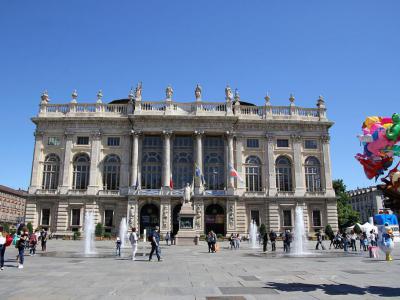Madame Palace and Civic Museum of Ancient Art, Turin
Madama Palace, planted in the middle of Castle Square, is a building with a split personality-and that’s what makes it fascinating. Its story begins in Roman Taurinorum, where two towers flanked a gate on the Decumanus Maximus, the city’s main east–west street. After Rome’s collapse, the gate did not retire quietly; it became part of the medieval defenses, proving that even ruins can find second careers.
By the 14th century, the property belonged to the Savoia-Acaja, a junior branch of the ruling dynasty. Prince Ludovico of Acaia rebuilt it into a square complex with a courtyard and four corner towers, details you can still spot today if you step around to the back.
In the 17th century, Christine Marie of France claimed the palace, enclosing the courtyard and upgrading the apartments to suit a royal widow. A few decades later, Marie Jeanne Baptiste of Savoy-Nemours moved in, and the nickname “Madama” stuck. The early 1700s brought in architect Filippo Juvarra, who gave the building its baroque white-stone façade. His grand project stopped midway in 1721, leaving the palace in its current form: part fortress, part theatre set.
The palace later moonlighted as the home of the Subalpine Senate before settling into its modern role. Since 1934, it has housed the Civic Museum of Ancient Art, with 35 rooms spanning Roman archaeology, medieval sculpture, Renaissance paintings, and decorative arts ranging from ivories to textiles.
For visitors, Madama Palace is more than a monument-it’s Turin’s history edited into one eccentric, unforgettable volume.
By the 14th century, the property belonged to the Savoia-Acaja, a junior branch of the ruling dynasty. Prince Ludovico of Acaia rebuilt it into a square complex with a courtyard and four corner towers, details you can still spot today if you step around to the back.
In the 17th century, Christine Marie of France claimed the palace, enclosing the courtyard and upgrading the apartments to suit a royal widow. A few decades later, Marie Jeanne Baptiste of Savoy-Nemours moved in, and the nickname “Madama” stuck. The early 1700s brought in architect Filippo Juvarra, who gave the building its baroque white-stone façade. His grand project stopped midway in 1721, leaving the palace in its current form: part fortress, part theatre set.
The palace later moonlighted as the home of the Subalpine Senate before settling into its modern role. Since 1934, it has housed the Civic Museum of Ancient Art, with 35 rooms spanning Roman archaeology, medieval sculpture, Renaissance paintings, and decorative arts ranging from ivories to textiles.
For visitors, Madama Palace is more than a monument-it’s Turin’s history edited into one eccentric, unforgettable volume.
Want to visit this sight? Check out these Self-Guided Walking Tours in Turin. Alternatively, you can download the mobile app "GPSmyCity: Walks in 1K+ Cities" from Apple App Store or Google Play Store. The app turns your mobile device to a personal tour guide and it works offline, so no data plan is needed when traveling abroad.
Madame Palace and Civic Museum of Ancient Art on Map
Sight Name: Madame Palace and Civic Museum of Ancient Art
Sight Location: Turin, Italy (See walking tours in Turin)
Sight Type: Museum/Gallery
Guide(s) Containing This Sight:
Sight Location: Turin, Italy (See walking tours in Turin)
Sight Type: Museum/Gallery
Guide(s) Containing This Sight:
Walking Tours in Turin, Italy
Create Your Own Walk in Turin
Creating your own self-guided walk in Turin is easy and fun. Choose the city attractions that you want to see and a walk route map will be created just for you. You can even set your hotel as the start point of the walk.
Turin Introduction Walking Tour
Mark Twain once wrote that Turin’s streets are “extravagantly wide” and its houses stretch “as straight as an arrow”-and he was not exaggerating.
Turin's story begins with the Taurini, a Celtic tribe whose name is tied to the word for “mountain.” They lived at the foot of the Alps before the Romans arrived. In 28 BC, the Romans founded Taurinorum here, designing it in their... view more
Tour Duration: 2 Hour(s)
Travel Distance: 3.4 Km or 2.1 Miles
Turin's story begins with the Taurini, a Celtic tribe whose name is tied to the word for “mountain.” They lived at the foot of the Alps before the Romans arrived. In 28 BC, the Romans founded Taurinorum here, designing it in their... view more
Tour Duration: 2 Hour(s)
Travel Distance: 3.4 Km or 2.1 Miles
Coffee, Food and Chocolate Tour in Turin
Among other things, the capital of Italy's Piedmont region – Turin – is well known for its rich culinary tradition, which includes long-standing coffee and chocolate culture. There are several cafes and coffee houses in the city that have been in business for hundreds of years.
The most notable of them are found in the historic heart of the city, such as the Caffè al Bicerin.... view more
Tour Duration: 1 Hour(s)
Travel Distance: 2.2 Km or 1.4 Miles
The most notable of them are found in the historic heart of the city, such as the Caffè al Bicerin.... view more
Tour Duration: 1 Hour(s)
Travel Distance: 2.2 Km or 1.4 Miles





